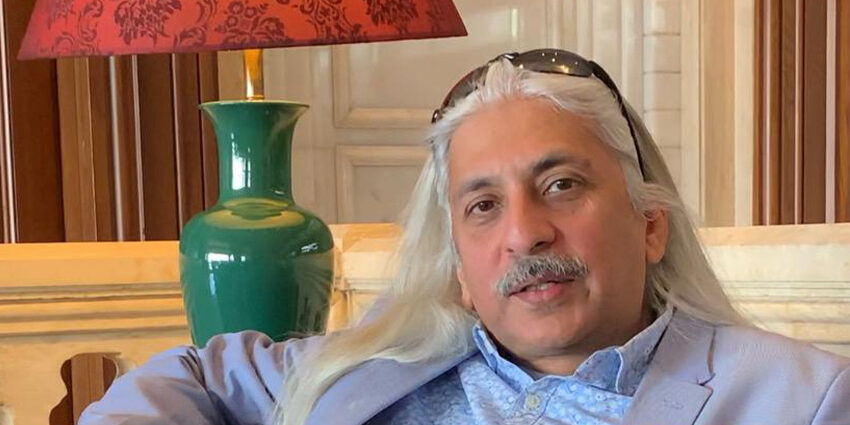Sanjoy Roy, Managing Director of Teamwork Arts and the man behind the annual Jaipur Literature Festival (the world’s largest free literary festival) is credited with creating the structure of literary fests in India. He spoke about events and e-events and emphasized on artistic approach and its impact in society and culture.
As he has an artistic mind, he can understand the problems of every artist across the globe who are most affected due to Covid-19. According to Sanjoy, artists are unable to perform or sell their crafts due to the pandemic and the subsequent lockdown. As they cannot sell or perform, they are unable to make their ends meet. He talked about ‘the pandal maker’, ‘the patchitra maker, ‘the mask makers in Sundarban’, ‘the Baul singers of Bengal’, ‘the flower artist at New Market in Kolkata’ and the likes. Everyone is starving because there is no performance and no selling of crafts.
Sanjoy Roy is an eminent personality and a brand in the art and culture field. He is a national awardee for the film ‘Shahjahanabad: The Twilight Years’. Sanjoy established Teamwork Arts in 1989. Teamwork Arts is a versatile production house that has a deep interest in several fields of arts like performing and visual arts, films, television, social sector, etc. Sanjoy is also a founder of Salaam Baalak Trust that works for the street and working children in Delhi.
As we all know, Sanjoy is the person who brought the Indian culture and art to the global level. Today, there are several literature festivals in India and all those are inspired by the Jaipur Literature Festival. He shared his whole journey of art and culture. He further said that he doesn’t want to take the entire credit of bringing Indian art at the global level. “India was always there, India has been discovered across million years and the kind of diversity, culture, education, and writing we have had is unparalleled”, he added.
Sanjoy was initially a theatre artist. He used to do theatre and sometimes street theatre to protest against dowry or violence and vouch for social changes through theatre. Sanjoy’s voice changed when he talked about theatre reflecting his love and passion for the art form. Sanjoy also suggested that students use their precious time. According to him, this is the time to study, to innovate, to explore the talent and also to learn from failing. He also suggested not to be afraid of failures and keep moving forward in life.
In 1991, the Indian Prime Minister P. V. Narasimha Rao started allowing the foreign and private broadcasters to work in Indian media. Teamwork Arts then started producing serials, daily soaps, talk shows, food shows, news programmes, etc. In 1995, Teamwork Arts made the most drastic decision. Sanjoy recalls one of the Saturdays when all the colleagues of Teamwork Arts had a meeting to discuss the company’s future programme and two of his colleague came to him and proposed him that they do not want to continue with this work.
After moving away from television, Sanjoy and Teamwork Arts took up an initiative to set up a platform for alternative music. A lot of trendy music emerging in India now was born by the hand of Teamwork Arts.
He also said, “We did the same in theatre by trying to offer something different to the existing rip-offs of Broadway or Western Shows and also started contributing in literature”. This was successful, and Teamwork Art continues with it. The organization started it with dance also.
According to Sanjoy, Art has a great impact on society and culture. Art can give the world the essence of positivity. He talked about Salam Baalak Trust, where they take care of underprivileged children of Delhi and rehabilitate them through arts and culture. Vicky Roy is an eminent and award-winning photographer who started his career with the Salam Baalak.
Salam Baalak also works in Australia, especially Western Australia, which houses 98 per cent of the global prisoners. Salam Baalak and Sanjoy Roy work there for prisoner’s reforms. He also came up with the example of Australian aboriginals. Seventeen Aboriginal communities in Kalgoorlie in Australia were transformed within six months through the initiatives of Sanjoy. To do this magic, they asked for three things to the government – the first one was a partner to track this programme during the six months, a supermarket truck for the transportation of aboriginals and they were asked to tell their stories. After six months, they come up with an amazing dessert installation programme. By this desert installation programme, the incarceration rate of that place came down to 26 per cent from 100 per cent. Sanjoy also talked about his South Africa project and New York Project.
Lastly, he said that science and arts complement each other. Everything in the world, whether it is a scientific gadget or a piece of art, cannot be made without the combination of scientific brain and artistic brain. He also said, “It’s our education system that separates science and arts. You need your scientific brain as well as artistic brains to design even a rocket. So, science and arts both need to sit together. Remove the fear of your brain and forget about the division between science and arts”.
According to Sanjoy, people hate numbers not because the numbers are problematic but because of the way the subject is taught. For Sanjoy, the joy of learning is the main success, and people need to enjoy the joy of the learning process. Sanjoy also suggested the importance of questioning. Sanjoy also encouraged young minds to start questioning what they read, what they watch and what they understand. Questioning also helps us to be rationalists. Event management not only consists of light, sound, and other operational activities but also needs an artistic mind to make it visually charming.
The author, Titas Biswas is associated with Adamas University Media School.







